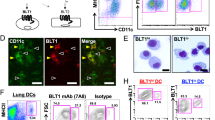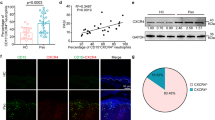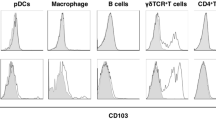Abstract
CD39, the endothelial ecto-nucleoside triphosphate diphosphohydrolase (NTPDase), regulates vascular inflammation and thrombosis by hydrolyzing ATP and ADP. Although ecto-NTPDase activities have been used as a marker of epidermal dendritic cells (DCs) known as Langerhans cells, the identity and function of these activities remain unknown. Here we report that Langerhans cells in CD39−/− mice express no detectable ecto-NTPDase activity. Irritant chemicals triggered rapid ATP and ADP release from keratinocytes and caused exacerbated skin inflammation in CD39−/− mice. Paradoxically, T cell–mediated allergic contact hypersensitivity was severely attenuated in CD39−/− mice. As to mechanisms, T cells increased pericellular ATP concentrations upon activation, and CD39−/− DCs showed ATP unresponsiveness (secondary to P2-receptor desensitization) and impaired antigen-presenting capacity. Our results show opposing outcomes of CD39 deficiency in irritant versus allergic contact dermatitis, reflecting its diverse roles in regulating extracellular nucleotide-mediated signaling in inflammatory responses to environmental insults and DC–T cell communication in antigen presentation.
This is a preview of subscription content, access via your institution
Access options
Subscribe to this journal
Receive 12 print issues and online access
$209.00 per year
only $17.42 per issue
Buy this article
- Purchase on Springer Link
- Instant access to full article PDF
Prices may be subject to local taxes which are calculated during checkout






Similar content being viewed by others
References
Banchereau, J. et al. Immunobiology of dendritic cells. Annu. Rev. Immunol. 18, 767–811 (2000).
Wolff, K. & Winkelmann, R.K. Ultrastructural localization of nucleoside triphosphatase in Langerhans cells. J. Invest. Dermatol. 48, 50–54 (1967).
Chaker, M.B., Tharp, M.D. & Bergstresser, P.R. Rodent epidermal Langerhans cells demonstrate greater histochemical specificity for ADP than for ATP and AMP. J. Invest. Dermatol. 82, 496–500 (1984).
Ralevic, V. & Burnstock, G. Receptors for purines and pyrimidines. Pharmacol. Rev. 50, 413–492 (1998).
Plesner, L. Ecto-ATPases: identities and functions. Int. Rev. Cytol. 158, 141–214 (1995).
Zimmermann, H. 5′-Nucleotidase: molecular structure and functional aspects. Biochem. J. 285, 345–365 (1992).
Maliszewski, C.R. et al. The CD39 lymphoid cell activation antigen. Molecular cloning and structural characterization. J. Immunol. 153, 3574–3583 (1994).
Kansas, G.S., Wood, G.S. & Tedder, T.F. Expression, distribution, and biochemistry of human CD39. Role in activation-associated homotypic adhesion of lymphocytes. J. Immunol. 146, 2235–2244 (1991).
Kaczmarek, E. et al. Identification and characterization of CD39/vascular ATP diphosphohydrolase. J. Biol. Chem. 271, 33116–33122 (1996).
Wang, T.F. & Guidotti, G. CD39 is an ecto-(Ca2+, Mg2+)-apyrase. J. Biol. Chem. 271, 9898–9901 (1996).
Zimmermann, H. Extracellular metabolism of ATP and other nucleotides. Naunyn Schmiedebergs Arch. Pharmacol. 362, 299–309 (2000).
Enjyoji, K. et al. Targeted disruption of cd39/ATP diphosphohydrolase results in disordered hemostasis and thromboregulation. Nature Med. 5, 1010–1017 (1999).
Marcus, A.J. et al. The endothelial cell ecto-ADPase responsible for inhibition of platelet function is CD39. J. Clin. Invest. 99, 1351–1360 (1997).
Gayle, R.B. III et al. Inhibition of platelet function by recombinant soluble ecto-ADPase/CD39. J. Clin. Invest. 101, 1851–1859 (1998).
Love-Schimenti, C.D. & Kripke, M.L. Dendritic epidermal T cells inhibit T cell proliferation and may induce tolerance by cytotoxicity. J. Immunol. 153, 3450–3456 (1994).
Filippini, A., Taffs, R.E. & Sitkovsky, M.V. Extracellular ATP in T-lymphocyte activation: possible role in effector functions. Proc. Natl. Acad. Sci. USA 87, 8267–8271 (1990).
Di Virgilio, F. et al. Nucleotide receptors: an emerging family of regulatory molecules in blood cells. Blood 97, 587–600 (2001).
Girolomoni, G. et al. Epidermal Langerhans cells are resistant to the permeabilizing effects of extracellular ATP: in vitro evidence supporting a protective role of membrane ATPase. J. Invest. Dermatol. 100, 282–287 (1993).
Di Virgilio, F. The P2Z purinoceptor: an intriguing role in immunity, inflammation and cell death. Immunol. Today 16, 524–528 (1995).
Coutinho-Silva, R. et al. P2Z/P2X7 receptor-dependent apoptosis of dendritic cells. Am. J. Physiol. 276, C1139–C1147 (1999).
Nihei, O.K., de Carvalho, A.C., Savino, W. & Alves, L.A. Pharmacologic properties of P2Z /P2X7 receptor characterized in murine dendritic cells: role on the induction of apoptosis. Blood 96, 996–1005 (2000).
Ferrari, D. et al. The P2 purinergic receptors of human dendritic cells: identification and coupling to cytokine release. FASEB J. 14, 2466–2476 (2000).
Pillai, S. & Bikle, D.D. Adenosine triphosphate stimulates phosphoinositide metabolism, mobilizes intracellular calcium, and inhibits terminal differentiation of human epidermal keratinocytes. J. Clin. Invest. 90, 42–51 (1992).
Pillai, S. et al. 1,25-Dihydroxyvitamin D3 upregulates the phosphatidylinositol signaling pathway in human keratinocytes by increasing phospholipase C levels. J. Clin. Invest. 96, 602–609 (1995).
Suter, M.M. et al. Extracellular ATP and some of its analogs induce transient rises in cytosolic free calcium in individual canine keratinocytes. J. Invest. Dermatol. 97, 223–229 (1991).
Mutini, C. et al. Mouse dendritic cells express the P2X7 purinergic receptor: characterization and possible participation in antigen presentation. J. Immunol. 163, 1958–1965 (1999).
Liu, Q.H. et al. Expression and a role of functionally coupled P2Y receptors in human dendritic cells. FEBS Lett. 445, 402–408 (1999).
Berchtold, S. et al. Human monocyte derived dendritic cells express functional P2X and P2Y receptors as well as ecto-nucleotidases. FEBS Lett. 458, 424–428 (1999).
Marriott, I., Inscho, E.W. & Bost, K.L. Extracellular uridine nucleotides initiate cytokine production by murine dendritic cells. Cell. Immunol. 195, 147–156 (1999).
Khakh, B.S. Molecular physiology of P2X receptors and ATP signalling at synapses. Nature Rev. Neurosci. 2, 165–174 (2001).
Sellers, L.A. et al. Adenosine nucleotides acting at the human P2Y1 receptor stimulate mitogen-activated protein kinases and induce apoptosis. J. Biol. Chem. 276, 16379–16390 (2001).
Burnett, C.A., Lushniak, B.D., McCarthy, W. & Kaufman, J. Occupational dermatitis causing days away from work in U.S. private industry, 1993. Am. J. Ind. Med. 34, 568–573 (1998).
Gocinski, B.L. & Tigelaar, R.E. Roles of CD4+ and CD8+ T cells in murine contact sensitivity revealed by in vivo monoclonal antibody depletion. J. Immunol. 144, 4121–4128 (1990).
Xu, H., DiIulio, N.A. & Fairchild, R.L. T cell populations primed by hapten sensitization in contact sensitivity are distinguished by polarized patterns of cytokine production: interferon γ-producing (Tc1) effector CD8+ T cells and interleukin (IL) 4/IL-10-producing (Th2) negative regulatory CD4+ T cells. J. Exp. Med. 183, 1001–1012 (1996).
Xu, S. et al. Successive generation of antigen-presenting, dendritic cell lines from murine epidermis. J. Immunol. 154, 2697–2705 (1995).
Matsue, H. et al. Induction of antigen-specific immunosuppression by CD95L cDNA-transfected "killer" dendritic cells. Nature Med. 5, 930–937 (1999).
Matsue, H., Bergstresser, P.R. & Takashima, A. Keratinocyte-derived IL-7 serves as a growth factor for dendritic epidermal T cells in mice. J. Immunol. 151, 6012–6019 (1993).
Inaba, K. et al. Generation of large numbers of dendritic cells from mouse bone marrow cultures supplemented with granulocyte/macrophage colony-stimulating factor. J. Exp. Med. 176, 1693–1702 (1992).
Kumamoto, T. et al. Induction of tumor-specific protective immunity by in situ Langerhans cell vaccine. Nature Biotechnol. 20, 64–69 (2002).
Mummert, M.E. et al. Development of a peptide inhibitor or hyaluronan-mediated leukocyte trafficking. J. Exp. Med. 192, 769–779 (2000).
Abeyama, K. et al. A role for NF-κB-dependent gene transactivation in sunburn. J. Clin. Invest. 105, 1751–1759 (2000).
Acknowledgements
We thank L. Ellinger, D. Edelbaum and P. Adcock for assistance. This work was supported by NIH grants (S.C.R. and A.T), the Dermatology Foundation fellowship award (N.M.), the Canadian Institutes of Health Research (J.S.), and the Centre de Recherches et d'Investigations Epidermiques et Sensorielles (CE.R.I.E.S.) award (A.T.).
Author information
Authors and Affiliations
Corresponding author
Ethics declarations
Competing interests
The authors declare no competing financial interests.
Rights and permissions
About this article
Cite this article
Mizumoto, N., Kumamoto, T., Robson, S. et al. CD39 is the dominant Langerhans cell–associated ecto-NTPDase: Modulatory roles in inflammation and immune responsiveness. Nat Med 8, 358–365 (2002). https://doi.org/10.1038/nm0402-358
Received:
Accepted:
Issue Date:
DOI: https://doi.org/10.1038/nm0402-358
This article is cited by
-
Adenosine metabolized from extracellular ATP ameliorates organ injury by triggering A2BR signaling
Respiratory Research (2023)
-
UTP increases wound healing in the self assembled skin substitute (SASS)
Journal of Cell Communication and Signaling (2023)
-
Conversion of extracellular ATP into adenosine: a master switch in renal health and disease
Nature Reviews Nephrology (2020)
-
Perioperative management of patients with atrial fibrillation receiving anticoagulant therapy
Journal of Anesthesia (2019)
-
The abnormal function of CD39+ regulatory T cells could be corrected by high-dose dexamethasone in patients with primary immune thrombocytopenia
Annals of Hematology (2019)



